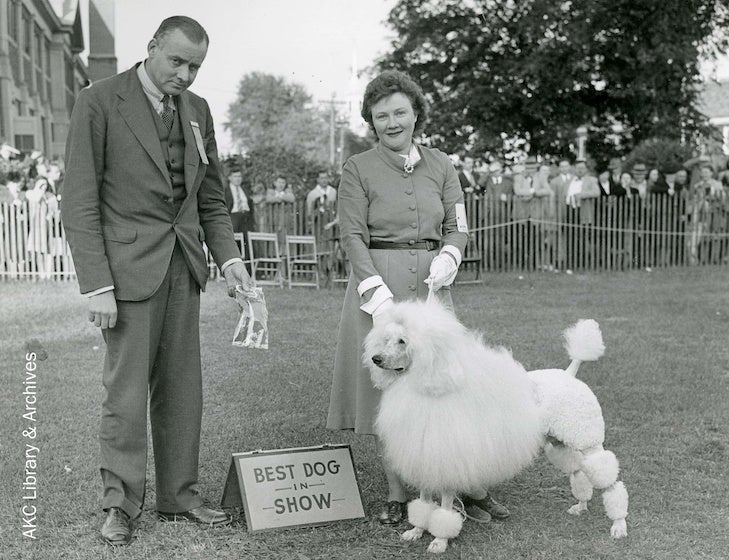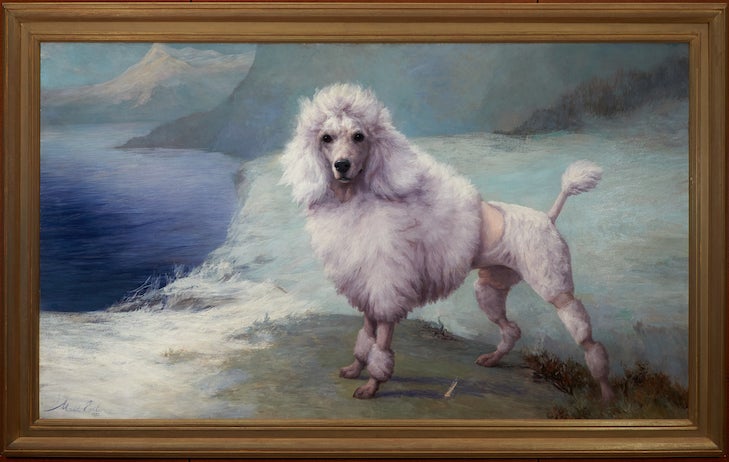
While every breed has a shot at winning Best in Show at any given dog show, there are some dogs whose stand-on-your-tippy-toes glamour simply makes them hard to ignore. And the Poodle, with his halo of perfectly coiffed fur and showy attitude (so distinctive that it has spawned its eponymous adjective – “Poodley”), is undoubtedly one of them. But that wasn’t always so.
Bringing Poodles To Prominence
After centuries of warming the laps of European royalty, the Poodle was among the first breeds recognized by the American Kennel Club, three years after its founding in 1884. But, a decline in popularity soon followed. Until well after the first World War, this sculpted French breed was dismissed by some as a carny of canines, and a circus-performer who did parlor tricks for his supper.
“Somehow, [the Poodle] became one of the great, lost breeds,” wrote Arthur Frederick Jones in the November 1933 issue of the AKC Gazette. “Some staunch followers kept him in existence, but his [conformation] prominence was somewhat less than that of the molecule, insofar as the show-going public was concerned.”
And then came “the Duke.”
A four-way international champion in Switzerland, France, Germany and England, Nunsoe Duc de la Terrace had hopscotched across Europe before landing in the United States in 1934. Born in Geneva and sold to the famous Nunsoe kennel in England, the magnificent white Standard completely revamped the breed’s reputation in America, paving the way for the primacy of the Poodle that is still in force today.
However, none of this would have been possible without the well-heeled figure at the other end of Duc’s lead. A descendant of Eli Whitney of cotton-gin fame, Charlotte Hayes Blake Hoyt was a woman of a certain social standing. She could have followed the lead of so many other dog-obsessed socialites of the era by hiring handlers to show the Poodles that she bred on her lakeside estate in Katonah, New York.
Instead, she slipped on her proper white gloves and entered the ring, becoming the first woman to take top honors at Westminster with Duc. The pair’s 1935 Best in Show was an inaugural one for the breed there as well.

The Hayes Blake Hoyt Way
Hayes Blake Hoyt was as competitive in spirit as she was comfortable in means. In February 1934, she finished Duc’s championship in Boston by surmounting what The New York Times called “insuperable obstacles” posed by a snowstorm that left most other exhibitors stranded or homebound.
“On snowshoes and leading her famous white champion of four nations, Nunsoe Duc de la Terrace, she broke a trail out from the kennels to the highway, getting to town and a train and finally getting here in time to go into the ring,” the paper reported.
It was that kind of intensity and focus that made Hoyt one of the first movers and shakers amongst the breed, affirmed longtime Poodle breeder and AKC judge Johnny Shoemaker.
“With her financial resources and very competitive nature, she was able to go to Europe, find and buy the best dogs, breed quite actively, then show them herself at a very high level,” agrees Paul Lepiane, founder and former publisher of Poodle Variety magazine. “By winning Best in Show at Westminster in 1935, Duc, became the first Poodle to triumph there, and he helped start the breed’s permanent place on the list of top winners in the 84 years that have followed.”
Hayes Blake Hoyt’s rise in the world of Poodles was nothing short of meteoric. When Jones wrote his article in 1933, the kennel had only been in existence for a year, but it was already, he explained breathlessly, “one of America’s leading kennels of Poodles.”
As might be expected, no cost was spared in constructing the kennels, which Jones called the “most unusual” in the country for their octagonal shape. That design was intended to minimize the need for heating. The reason was not to save money but to avoid the drying effects of artificial heat, which impeded the growth of good coats.
“Our kennels are very new, but our ambitions are very old,” Hoyt told her interviewer. “We want to raise the best possible Poodles from pure color lines, black, white, and brown.”
While she had seen an “exquisite” new color – apricot – on one of her trips to England, she worried that the bright American sun would wash out its rich hues. While on the same trip, she saw several symmetrically marked particolors, but she refused to deviate from the long-accepted solid palettes found in her kennel.
That ironclad attention to tradition, as well as appearance, was an undercurrent in Hoyt’s attitude toward her new breed, which her husband had owned as a youngster. Poodles would earn their keep with the next generation, too, when the Hoyts’ 2-year-old son toddled away from his nanny, but his beeline to a nearby pond was blocked by a Poodle who refused to budge.
“As Mr. and Mrs. Hoyt put it, the Poodle must live down his past, must make himself recognized as a dog of true value,” Jones wrote, as if the breed’s dip in popularity was a social gaffe, on par with running off with the chauffeur. “Never again can he be a fad, and survive.”
A Duke Among Dogs
The arrival of Duc in 1934 put Hoyt’s upstart kennel on the map. He was a surprise gift from her mother, who reportedly reversed his not-for-sale status by offering his owner Jane Lane of Nunsoe the astronomical sum of £1,000, or about $75,000 today. And so “of Blakeen” was tacked to the end of Duc’s already weighty registered name.
Duc continued his winning ways in the United States, going undefeated in the breed ring the 18 times he was shown, and only failing to win the group twice. Of his 16 group wins, nine resulted in a Best in Show – including, of course, that most famous one of all at Madison Square Garden.
A novice handler, Hoyt said she had gained her confidence from her seasoned show dog’s own abundance of it. She remembered Duc stopping traffic and drawing crowds when she walked him in New York, where the Hoyts maintained a residence.
In addition to her enviable track record as a breeder and handler, Hoyt was also an influential judge and writer, authoring such books as “Your Poodle” and “All You Need to Know About Dogs.” Her most widely read piece, however, was a 1966 essay, “Type, Soundness, Style, Quality,” which unequivocally defined those four terms and what they should mean to good dog people.
Hoyt did dabble in other breeds as well. She owned the top-winning Afghan Hound Ch. Rudiki of Pride’s Hill, and the renowned painter and AKC library chair Edwin Megargee persuaded Hoyt to breed Gordon Setters.

While Megargee never painted Duc, one of his celebrated colleagues, Maud Earl, did. Duc unveiled the painting himself, tugging on a rubber rat toy that had been tied to the fabric draping the canvas. It was that characteristic confidence and humor that enamored Hoyt of her beloved Duc and the breed that she helped popularize.
“He never knew he was great or unique or a showman, for he was unselfconscious and completely himself,” Hayes Blake Hoyt wrote in a memorial to Duc in the Gazette after his death. “He was far beyond the ownership of any man or woman, for he reflected only himself, a noble and majestic personality. It was a privilege to know him, and a boon to lovers of the canine race that he was a dog.”

